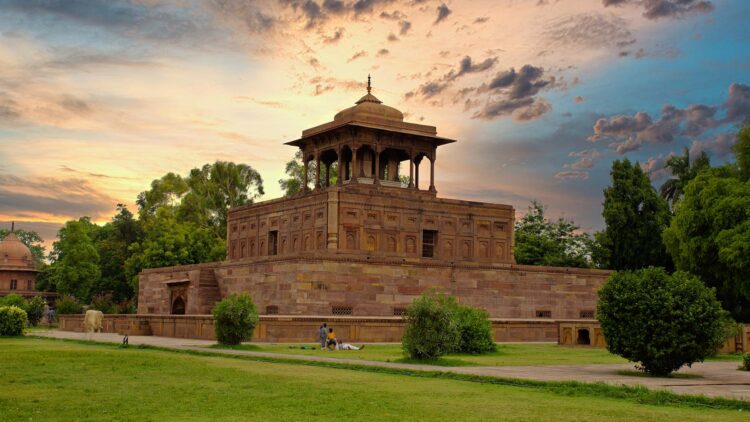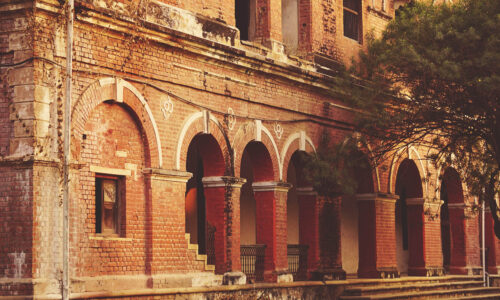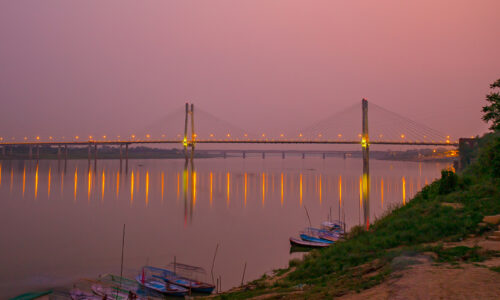This is part 2, of the article Once Upon a Time in Prayag – Part 1.
The Fort and Tomb Complex: Mughal Monuments in Allahabad
The Fort and the tomb complex known as Khusrau Bagh are the two main Mughal monuments of Allahabad. Located on the imperial highway and accessible from the capital Agra both by land and river, the Fort served as the symbol of Mughal paramountcy in Eastern India. Divided into four segments, the fort in its original shape was an irregular triangle enclosed by a high red sand stone wall overshadowed by three imposing gateways, the main one being protected by a deep moat. The fort is 2280 yards long, 1560 yards wide and covers an area of 983 bighas. It was built entirely of red sand stones and other building material like glass, iron or bricks were not used at all in its construction. The fort lost much of its originality and architectural beauty when the British occupied it in 1798. The towers and upper storeys of the main gateway were dismantled and replaced by batteries and lunettes. The battlements on the river front were also destroyed and the Yamuna gate was closed.
Of the original buildings that have survived the ravages perpetrated by the British, the most important is the Zenana Mahal known today as Rani Mahal. It is a three-storey building situated in a spacious courtyard. The ground floor is an extensive hall of 64 pillars while the first floor “bears a large central chamber surrounded by eight ancillary ones and an encompassing veranda.” These days it is in a poor state of maintenance.
Emperor Asoka’s Pillar: An Important Monument
The famous pillar of Emperor Asoka is another important monument situated within the fort complex. Prince Salim (later Emperor Jahangir) is reported to have erected it during his sojourn in Allahabad. After his accession to the throne, Jahangir had his complete genealogy inscribed on the pillar along with the edict of Asoka and inscriptions of king Samudragupta and Raja Birbar.
Khusrau Bagh
Jahangir also built a char bagh (four part pleasure garden) in Allahabad. Spread over an area of approximately 64 acres and now known as Khusrau Bagh, the garden became the final resting place of Jahangir’s wife and Khusrau’s mother Man Bai (d.1604). It is a three- storeyed structure built entirely of Chunar Red stone. After Khusrau’s death (1622), his mortal remains were also interred in the garden. Subsequently Khusrau’s elder sister Princess Sultan Nisar Begum (d.1646) built a magnificent tomb over his grave. She also constructed a mausoleum for herself in the garden. She was however destined to die in Agra and was buried in her grandfather’s mausoleum in Sikandra. This tomb is therefore empty. The tombs of Khusrau and his sister are double-storeyed and were also built of Chunar sandstone. Their exterior is bereft of any decorative motif but the interiors are embellished with a variety of mural paintings. The paintings on Sultan Nisar Begum’s tomb are regarded as “the best preserved examples of painting in any Mughal tomb”.
Symbolism and Significance of Mughal Architecture
Architecture in Mughal India was not only a medium for display of aesthetic taste and the cultural predilection of its patrons; it also served quite forcefully to demonstrate wealth, power and splendour. Just as centuries ago Asoka had planted his edicts and pillars in all parts of his huge empire, not only to propagate his teachings but also to create legitimacy for his dynasty, the Mughals also used their buildings as symbols of their presence and authority in India. Little wonder that some of our countrymen look upon these splendid monuments as symbol of slavery. They also know that any harm rendered to these works of art would lead to world-wide condemnation. In their scheme of things therefore, changing the name of the cities where these buildings stand is perhaps the next best option to obliterate these signs of a “Muslim past” from public memory. Past history in this way merges with present politics.
This article was originally published in The Indian Express on October 28th, 2018. The link to the article is – https://indianexpress.com/article/express-sunday-eye/once-upon-a-time-in-prayag-5420922/



